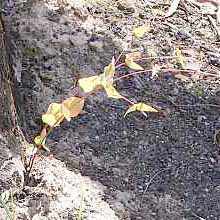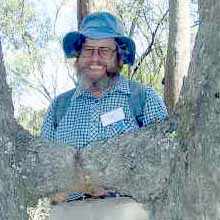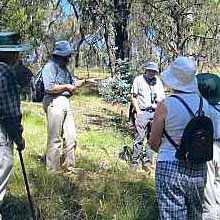Effect of fire on the Landscape – Jerusalem Creek
The leader was Dr Kevin Tolhurst, Senior Lecturer in Fire Ecology and Management, University of Melbourne.
This excursion was to investigate the impact of fire in the area of a prescribed burn by Parks Vic. It is a dry sclerophyll area of predominantly Box eucalypts. The site was just up from the Jerusalem Creek boat ramp and was burnt about 12 months ago.
We only wa1ked about 40 metres into the forest but found numerous examples of how the fire had impacted on the vegetation and were shown what to look for in gauging fire intensity.
- Baked soil. The soil around a burnt dead tree had been changed by baking due to a trunk fire which lasted for about 2 hours, compared with the ground fire which may have lasted only a few minutes. These ash beds provide a micro habitat for species such as ferns and bryophytes such as lichens and mosses to germinate and get established without competition.
- Resprouting species. The eucalypts have resprouted from epicormic buds. About 70% of species on the site are resprouting species e.g. shaggy pea and guinea flower. Only about 7% of the heat of the fire would have got through the soil so that any plants that have buds below the surface were resprouting. Although many plants can resprout, there still needs to be the opportunity presented by fire for seeds to germinate so that the plant can reproduce itself e.g. one shaggy pea noticed was around 50-60 years old.
- Sexual reproduction. Even long lived bracken needs to go through a reproductive phase. So there is a need for these odd opportunities for some species to revegetate rather than just resprout.
- 60 degrees is critical for mortality and here the scorch and charring lines on the trunks were quite low although sometimes a scorch line may trickle up the trunk for a distance.
- Canopy removal. For regeneration there is also a need tor some canopy removal for rain to hit the ground and for light to encourage growth.
- Seedlings. We were shown a small Cassinia that had come up since the fire as a seedling and an area of burnt Red-anther Wallaby-grass which had already been colonised by two Hovea seedlings. Provided there are sufficient periods of no fire then there is a leap frogging effect of species renewal.
- Bark removal. As the bark layer of eucalypts is vital to their protection frequent bums can progressively reduce this layer and could effectively ring-bark the tree.
- Burn frequency. There is the problem of burning some areas too often and some not enough. e.g. frequent grassland burns can lead to degradation of nutrients but low density fires can help thin the undergrowth. Burning needs to be decided according to the plant level, not by the hectare level.
- Key response species. Need to identify key fire response species (80% on the site), then see if they have recovered as expected.
- Drought can effect regeneration.
- Rain after big forest fires washes away nutrients and causes erosion and loss of species. It fills streams and holes formerly occupied by native Blackfish. The eroding effects of the 2003 fires are still obvious – especially in the Gippsland Lakes.
Contrasting unburnt with the burnt site, we noticed more twiggy and leafy material. 20% moisture is needed for breakdown of leaf litter. During the 1983 drought there was twice the litter level.
We ran out of time to see a second site of gum eucalypts and could have asked questions for hours – perhaps days. Just in time for a sidetrack to Mt Piniger Lookout for a view down to the new wall and the busy lake. Also views to the burnt peak of Mt Torbreck and the folds of eucalypts on the nearer hills.
A hot afternoon in the bush but a facinating one and we learnt a lot. Many thanks to Kevin for sharing his knowledge.
Cherry Ballart has been ringbarked by the fire. The bark at the base has peeled away from the trunk.Despite the ringbarking, the tree has put out new leaves in the crown. Cherry Ballart is a root parasite, and is obtaining nutrients for the roots from the nearby host plants. The tree is also producing suckers at the base.

Dense suckers at the base of a Long-leaf Box.

Sucker at the base of a Peppermint.

Kevin Tolhurst with unusual tree growth. Photo: Upper Goulburn FNC.

Kevin Tolhurst at the burnt area. Photo: Upper Goulburn FNC.